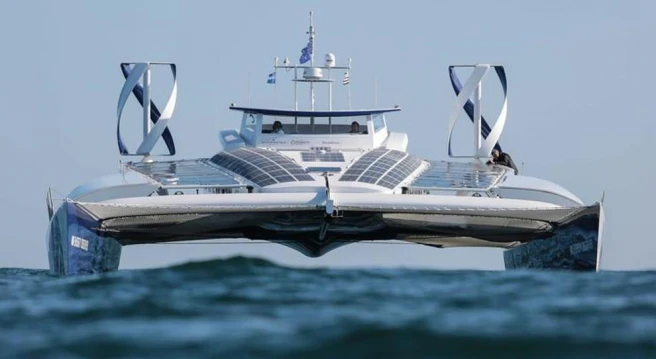
Energy Observer, the first hydrogen vessel
Energy Observer finished its Italian tour discovering sustainable innovations
- Arrived in Venice on July 6th, Energy Observer completed its tour of Italy this Sunday, August 5th.
- The catamaran has traveled more than 1100 nautical miles around the Italian peninsula making 3 stopovers and passages in the Straits of Messina and Capri.
- During their journey, the crew met many Italian actors for the ecological transition.
- The catamaran yesterday joined the port of Bastia in Corsica before reaching Saint-Tropez on August 11th.
Energy Observer, the first hydrogen vessel around the world, has left Italian waters. From Venice, the vessel completed a full tour around the boot, to discover its coasts and the country's sustainable innovations. The vessel made 3 stopovers and passed the milestone of 8,000 nautical miles traveled, often in stormy conditions.
Energy Observer left Italian waters this Sunday, 5th of August. After leaving Venice, the vessel made its first stopover in Bari, then on to Messina, before sighting the volcano Mount Stromboli and making one last stopover in Salerno.
Navigation conditions were very windy during this voyage with a crosswind, enabling the testing of the structural resistance of the boat. The crew faced many storms which forced the vessel to not approach coasts during its travels. After traveling more than 1,100 nautical miles around Italy, Energy Observer left the Italian coast at Cala Picola, in the south of the Tuscan archipelago, where it set its course for Corsica.
Finding concrete solutions for the future
In Italy, many projects are appearing to enable the country to meet the challenge of an ecological transition. Energy Observer has discovered some of them as part of “The Odyssey for the Future”, the documentary series that will broadcast this fall on Planète+, or the Web series SOLUTIONS currently in production.
Accadueaccadia: generating hydrogen using wind
Puglia is the first region to produce wind-powered energy in Italy. However, up to 40% of this energy is lost at peak production times due to inadequate storage facilities. To solve this problem, the Accadueaccadia project set up a system already familiar aboard Energy Observer, allowing to convert the excess of renewable energy produced into hydrogen via electrolysis. Concrete proof that the energy model advocated by the first hydrogen-powered vesselaround the world has a future.
A city lit up thanks to LED lights
The transition also occurs at the local level, and across public-private partnerships. A few kilometers from Rome, the town of Frosinone, in collaboration with ENGIE, took up the challenge on energy transition by replacing the light bulbs of 8,300 of the town's street lights with LED lighting, equipped with automatic flux control. The objective: to upgrade 100% of the town's public lighting system and reduce greenhouse gas emissions: thanks to this project, by 2030, it is more than 12,000 tones of CO2 that will be avoided.
Autonomous ports thanks to wave-farmed energy
In the south of the Italian Boot, the University of Calabria intends to develop positive-energy ports. In Messina, thanks to a system installed on port infrastructures, the permanent movement of waves creates an inexhaustible source of energy, night and day. A solution that should enable the production of 6,000 and 9,000 MWh per kilometer per year, the equivalent of the average annual consumption of 1,900 households.
The research, a key sector in the fight against climate change
Understanding in order to find solutions, this is the primordial role of researchers in the fight against climate change. In Italy, two research projects have attracted the crew's attention in particular:
Nemo's Gardens, agriculture of the future under the sea
Near Noli, in the depths off the Ligurian coast, a futuristic method of agriculture is emerging: submarine greenhouses. Created thanks to a collaboration between the company Ocean Reef, which manufactures diving equipment, and the University of Pisa, submarine spheres two meters in diameter installed 10 meters deep, house basil, sage, quinoa, aloe vera and strawberry crops. No problems regarding frost, insects, or drought, everything can be adjusted and controlled. A project still in its experimental phase, but one which could well give rise to a concrete solution to the issue of feeding nearly 9 billion human beings.
Understand microplastics with Plastic Busters
The Mediterranean Sea is one of the seas the most polluted by plastics. In Sienna, Plastic Busters' team studies the infinitely small to better understand how to effectively fight against plastic on a large scale. Since 2013, they have been analyzing the effects of microplastics in protected maritime areas in the Mediterranean, through skin samples of marine animals.
The Odyssey for the future continues, with a brief return to France
Energy Observer is currently making a technical stopover in Bastia, Corsica until 08/10.
It will return to sea until reaching Saint Tropez, where the vessel will be seen in the afternoon in the old port and anchored the rest of the time. The digital exhibition will welcome visitors to discover pedagogical contents and visit the vessel in virtual reality, from the 11th to 15th of August at the Épi dock.




